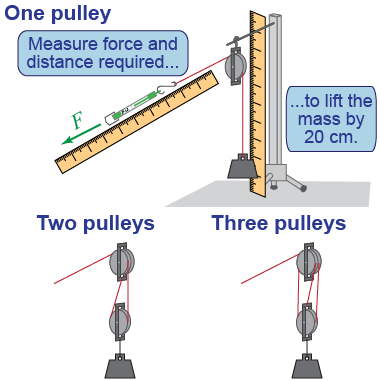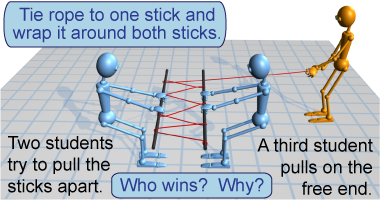|
| Essential questions | | How do you use pulleys to lift a heavy object?
Does a system of pulleys change the work required to lift an object? | |
|
Pulleys can be used to change the direction of the force needed to lift an object and also to reduce the force needed to lift it! The block and tackle is a simple machine that can be used to lift heavy objects. In this investigation, you will combine two or more pulleys to form a block-and-tackle system. In each case, you will measure how far you have to pull on a string to lift the mass by 20 cm and record the force required to do so. 
|
Part 1: Block-and-tackle system of pulleys

- Use the spring scale to measure the weight of the mass provided.
- Run the cotton or nylon string over one pulley. Attach the mass to one end and connect the spring scale to the other end. Use a meter stick to measure the distance d the string must be pulled, and use a spring scale to measure the force F required to lift the mass by 20 cm.
- Construct a two-pulley and a three-pulley block-and-tackle system. Repeat the measurements of distance d and force F for each case. Tabulate your results.
- How did the distance that you had to pull on the string vary? How did the force vary?
- Use the measured force and distance to calculate the work done to lift the mass in each case. How did the work done vary?
- How did the work done compare with the change in potential energy of the mass? Explain.

|
Part 2: Broomstick pulleys

- Have two students hold a pair of broomsticks approximately two feet apart.
- Have a third student tie a rope or cord to one broomstick, and then wrap the rope back and forth between the two broomsticks.
- By constructing a model based on the physics of simple machines, predict who will be able to pull harder, the two students holding the broomsticks or the third student pulling on the free end of rope.
- Once you have made your prediction, have the three students pull to see who can exert the most force.
- Who pulls harder, the first two students or the third one?
- Explain why this system is similar to a block-and-tackle system of pulleys.

|

